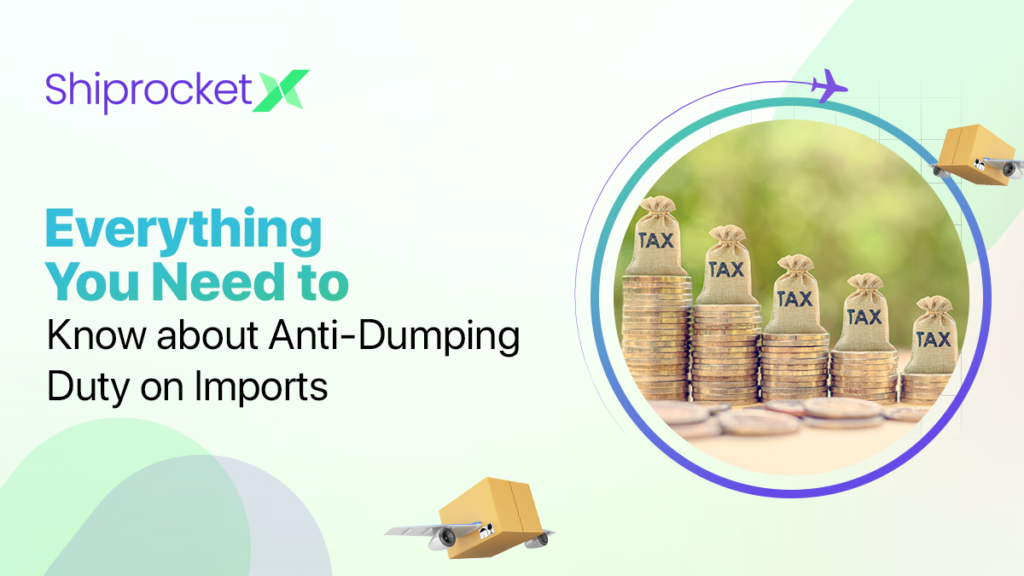Anti-Dumping Duty: What It Is, Example, & Calculations
Anti-dumping duty (ADD) on imports is a necessary step taken by the government to safeguard the financial interests of local manufacturers and traders. The process is complex but essential in the current times as businesses are expanding globally and entering different markets trying to capture a major share. Statistics reveal that India has filed around 20% of all the global anti-dumping cases. This is quite high in comparison to its global import share which stands at 2%. But what exactly is anti-dumping duty and why is it so important for countries? What are its estimation methods? Let’s find out! We have explained the concept with examples for better understanding! As a business owner, you must understand this.

Anti-Dumping Duty: What is It?
To understand what is Anti-dumping duty, it is important to learn what is dumping. Dumping refers to the practice of selling goods in a foreign market and pricing them much less than the local traders. This practice often leads to a decline in the sales of domestic brands. They struggle hard to compete with those low prices but largely fail to do so. It leads to the closure of local brands and the loss of jobs for thousands of workers engaged in domestic factories. This is where the anti-dumping duty comes into play. Anti-dumping duty is a customs duty formulated by The Directorate General of Trade Remedies to protect local industries from the pricing strategies of foreign brands.
The main objective behind this duty is to lower the impact caused by dumping. Implemented under section 9A of The Customs Tariff Act, 1975, it levels the playing field and helps create a healthy market competition.
Several countries including India conduct extensive anti-dumping investigations and take necessary actions to protect the interests of their domestic traders. This shows these countries’ efforts towards safeguarding their local businesses. It is a step towards strengthening their economies.
The World Trade Organization (WTO) regulates how the governments of different countries can react to dumping. WTO keeps a check on the process of anti-dumping to discipline this action. This is referred to as Anti-Dumping Agreement. This agreement enables governments to take necessary action in cases where dumping is seriously impacting the domestic industry.
It has been agreed that the governments of the countries facing challenges due to dumping must collate the necessary data to show that they are facing this issue. They must calculate the extent to which dumping is taking place by considering the exporter’s home market price. The governments must prepare a report to show that the dumping is leading to losses for their domestic businesses. This helps determine whether or not the Anti anti-dumping duty levied by them is justified.
Anti-Dumping Duty Example
Let us understand anti-dumping duty in a better way with the help of a few examples. For instance, China produces mobile phones and sells them in its local market for an amount which is equivalent to INR 15,000. However, the same product is sold at a lower price by that Chinese brand when it is exported to India or some other country. This means that it sells the same mobile phones for INR 10,000 in the Indian market knowing well that similar mobile phones are being sold at INR 12,000 or more in India. The exporter strategically chooses to sell the product at a lower price to capture the market. In this scenario, China is dumping its mobile phones into India to get an unfair advantage.
Let us take a look at another example. Supposedly, local brands in India are selling luxury wristwatches for men and women at INR 10,000. A well-known luxury watch brand in Switzerland targets India to expand its market. It will start its expansion plan by studying the prevailing rates of watches in India. It will sell luxury watches with similar features for INR 7,000 (or anything less than INR 10,000). Even though the brand may be selling the same watches for INR 12,000 in its domestic market, it will slash the rates for Indian customers to make its place in the Indian market. Here, you can say that Switzerland is dumping its luxury watches in India.
To protect the Indian industries from financial loss, the Indian Government must take strict anti-dumping action. Anti-dumping duty helps establish a fair trade in the market by negating the impact of dumping.
Anti-Dumping Duty Estimation Methods
Before computing the anti-dumping duty, an extensive investigation is conducted by the governments of the affected countries. Let us understand the way this investigation is carried out before learning about the estimation methods used for calculating anti-dumping duty. The investigation is carried out in two different ways. These are as follows:
- Suo-Moto by Directorate – The investigation may be initiated by The Directorate General of Trade Remedies (DGTR). The office can do so if it feels that a certain foreign brand is causing dumping in the country leading to financial loss of local manufacturers and sellers.
- Written Application Submitted by Domestic Industry – The investigation can be initiated by the appeal of a domestic industry experiencing the brunt owing to the dumped imports in the market. The industry should send a formal application to the government.
As the investigation begins and the need to levy Anti-Dumping duty is felt, the same is calculated using the below methods:
- Margin of Dumping (MOD) – Using this method, the price at which the product is exported is subtracted from the domestic selling price of the exporting country.
- Injury Margin (IM) – The difference between the Landed Cost (the product’s cost when it arrives at the importing country) and the Fair Selling Price (the rate set for selling the product in the local market under normal conditions) determines the Injury Margin.
Whichever of the two is lower in amount is set as the anti-dumping duty. For instance, if MOD is INR 100 per unit and IM is INR 120 per unit then the anti-dumping duty would be INR 100 per unit.
Conclusion
Dumping causes financial losses for domestic manufacturers and sellers. Anti-dumping duty is necessary to protect their interest and ensure a fair trade. It involves levying additional import duty on a specific product from a specific exporting country responsible for dumping. Adding this additional charge helps bring the price closer to the rate at which similar products are being sold in the local market. The aim is to heal the impact of dumping on the domestic market. It provides an equal chance to the local businesses enabling them to compete against foreign companies. Research shows that the anti-dumping cases filed by India mainly focus on the chemicals industry. Also, the country’s anti-dumping largely targets other developing countries. ADD is determined after extensive investigation. A lot of things are taken into account to determine this duty.
Anti-dumping duty was imposed by India for the first time in 1992.
The normal value and the export price of an item are the parameters that are taken into account to assess the dumping of goods from a country. If the export price of an item is less than its normal value then it is referred to as dumping.
Anti-dumping duty is mostly valid for 5 years. The 5 years period starts from the day its notification is published in the Union Gazette. The government has the right to amend or revoke ADD before the mentioned period.






